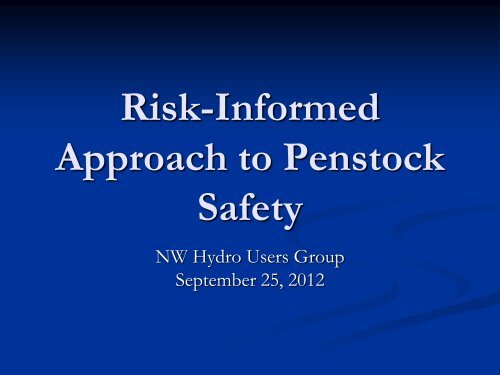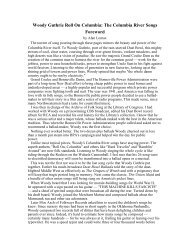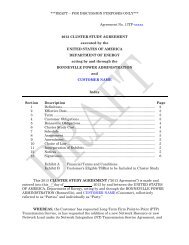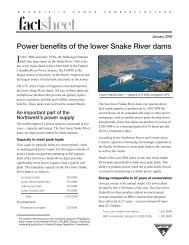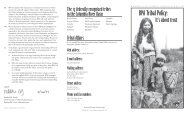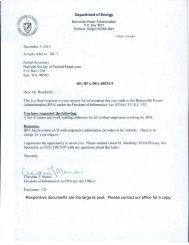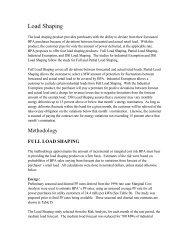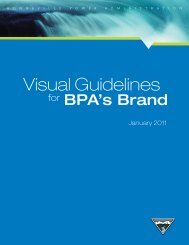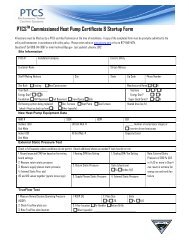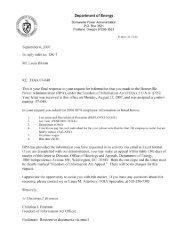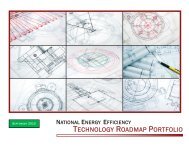Risk-Informed Approach to Penstock Safety - Pat Regan
Risk-Informed Approach to Penstock Safety - Pat Regan
Risk-Informed Approach to Penstock Safety - Pat Regan
Create successful ePaper yourself
Turn your PDF publications into a flip-book with our unique Google optimized e-Paper software.
<strong>Risk</strong>-<strong>Informed</strong><br />
<strong>Approach</strong> <strong>to</strong> Pens<strong>to</strong>ck<br />
<strong>Safety</strong><br />
NW Hydro Users Group<br />
September 25, 2012
Pens<strong>to</strong>ck <strong>Risk</strong> Assessment<br />
�Failure Modes<br />
�Consequences
FERC Database<br />
� Geotechnical Issues (23)<br />
� Deterioration (21)<br />
� Vacuum (15)<br />
� Flood (6)<br />
� Water Hammer (5) 3 included some degree of opera<strong>to</strong>r<br />
error<br />
� Fabrication Errors (4)<br />
� Couplings (4)<br />
� Ground Water/Opera<strong>to</strong>r Error (1 each)<br />
� Other/Unknown (10)
Hazards by Regions<br />
Total ARO CRO NYRO PRO SFRO<br />
Unknown 2 0 0 2 0 0<br />
Coupling 4 0 0 1 1 2<br />
Deterioration 21 1 2 8 8 2<br />
Fabrication 4 0 0 0 2 2<br />
Flood 6 0 0 5 1 0<br />
Geotechnical 23 3 0 2 8 10<br />
Ground Water 1 1 0 0 0 0<br />
Operation 1 0 0 1 0 0<br />
Other 8 2 1 1 3 1<br />
Vacuum 15 0 1 6 6 2<br />
Water Hammer 5 0 0 0 1 4<br />
Total 90 7 4 26 30 23
FERC Pens<strong>to</strong>ck Data<br />
ARO CRO NYRO PRO SFRO<br />
Ave. Head 231 155 93 306 724<br />
Max. Head 1380 854 1148 2387 2616<br />
Min. Head 14 18 3 14 6<br />
Ave. Diameter 12 10 10 8 5<br />
Max. Diameter 26 49 30 28 25<br />
Min. Diameter 2 2
Geotechnical/Geological<br />
� Soil/Rock movement including landslides<br />
� Rockfall<br />
� Bearing failure
Pho<strong>to</strong> - Caribou PH
� Vacuum<br />
Equipment Malfunction<br />
� Air valve failure<br />
� Debris plugging air vents<br />
� Icing of air vents<br />
� Mis-operation<br />
� Water Hammer<br />
� Governor failure / wear<br />
� Wicket gate failure<br />
� Pel<strong>to</strong>n needle failure<br />
� Mis-operation
Pho<strong>to</strong> - Vacuum - Equipment<br />
Failure
Pho<strong>to</strong> - Collapsed Pipe<br />
Mechanical Equipment Failure
Pho<strong>to</strong> - Lapino
Pho<strong>to</strong> - Pinawa<br />
flooded PH
Pho<strong>to</strong> - Oak Grove Flowline<br />
<strong>Pat</strong>ch and Replacement
Pho<strong>to</strong> – Shoshone Ruptured<br />
Pens<strong>to</strong>ck
Aging/Deterioration<br />
� Lack of Maintenance<br />
� Erosion of invert<br />
� Stress-Corrosion Cracking<br />
� Cavitation<br />
� Acidic Soil
Pho<strong>to</strong> - Big Fork – Wood Stave<br />
Deterioration
Pho<strong>to</strong> - Wood Stave Soaker Hose -<br />
Material Degradation
Pho<strong>to</strong> - Leak in Expansion Jt
Pho<strong>to</strong> - Forged Weld Material Degradation
Pho<strong>to</strong> – Balch<br />
Pens<strong>to</strong>ck Demo
Pho<strong>to</strong> - Balch PH Crack Due To<br />
Stress/Corrosion<br />
2 ¼”
Pho<strong>to</strong> - Oak Grove Flowline<br />
Corrosion Issues
Pho<strong>to</strong> - Big Creek Collapsed Crib
Pho<strong>to</strong> - Big Creek Collapsed Crib
Pho<strong>to</strong> - Big Creek -<br />
Cracked Saddle
� LCC<br />
Fabrication<br />
26 ft
Flood<br />
� Pho<strong>to</strong> of Power Creek<br />
Buckled Pipe
Organization/Opera<strong>to</strong>r Error<br />
� Poe Tunnel Liner
� Reconstruction<br />
� Pens<strong>to</strong>ck<br />
� Powerhouse<br />
� Switchyard<br />
� Lost Generation<br />
� Property Damage<br />
� Loss of Life<br />
Consequences<br />
� Environmental Mitigation
Shoshone PH
<strong>Risk</strong>-<strong>Informed</strong> <strong>Approach</strong> <strong>to</strong><br />
Pens<strong>to</strong>ck <strong>Safety</strong>
Age Profile
R&D Program<br />
� Establishment of pens<strong>to</strong>ck database<br />
� Development of risk assessment program
Pens<strong>to</strong>ck Database<br />
� MS Access format<br />
� Included information on:<br />
� Head<br />
� Flow<br />
� Material<br />
� Length<br />
� Thickness<br />
� Age<br />
� etc.
<strong>Risk</strong> Assessment Methodology<br />
� Focuses on:<br />
� Hazards<br />
� Consequences<br />
� Determines <strong>Risk</strong>
Definitions<br />
� Hazard - Conditions that by themselves or in conjunction with<br />
other conditions can lead <strong>to</strong> a pens<strong>to</strong>ck failure - expressed in<br />
terms of occurrences/year<br />
� Consequence - Damages that may occur in the event of a failure<br />
expressed in terms of $ (Life safety consequences were not<br />
considered)<br />
� <strong>Risk</strong> - The product of Hazards and Consequences expressed in<br />
terms of $/year<br />
� Probabilistic <strong>Risk</strong> Assessment<br />
� A range of possible values is estimated for the probability of occurrence<br />
for pertinent hazards and consequences<br />
� The program determines the probabilistic risk for each pens<strong>to</strong>ck
� Geotechnical<br />
� Hydrologic<br />
� Seismic<br />
Hazards Considered<br />
� Equipment Malfunction<br />
� Site Specific
Consequences Considered<br />
� Pipe replacement<br />
� Geotechnical stabilization<br />
� Damage <strong>to</strong> powerhouse<br />
� Damage <strong>to</strong> switchyard/transmission facilities<br />
� Lost generation<br />
� Property damage<br />
� Environmental damage
Name<br />
A1<br />
A2<br />
A3<br />
Cost Spreadsheet<br />
C1 - Pipe Replacement C2 - Geotechnical C3 - Powerhouse<br />
Cmin Cexp Cmax Std Dev. Cs<strong>to</strong>ch1 Cmin Cexp Cmax Cs<strong>to</strong>ch2 Pstrike Cmin Cexp Cmax Cs<strong>to</strong>ch3<br />
908 2214 3820 221 2210 2500 5000 15000 5438 1.00 0 5000 10000 3675<br />
962 1202 1442 120 1194 2500 5000 15000 5323 1.00 0 500 1000 365<br />
561 962 1442 96 964 2500 5000 15000 5283 1.00 0 250 500 187<br />
C4 -<br />
Switchyard/Transmission C5 - Lost Generation C6 - Property Damage<br />
Cmin Cexp Cmax Cs<strong>to</strong>ch4 Cmin Cexp Cmax Cs<strong>to</strong>ch5 Cmin Cexp Cmax Cs<strong>to</strong>ch6<br />
2700 5400 16200 5739 1,219 2,439 7,316 2534 2000 4000 12000 4274<br />
2700 5400 16200 5666 114 227 682 242 2000 4000 12000 4237<br />
2700 5400 16200 5754 93 187 560 197 2000 4000 12000 4237<br />
C7 - Environment Total Break Cost<br />
Cmin Cexp Cmax Cs<strong>to</strong>ch7 CTmin CTs<strong>to</strong>ch CTmax<br />
4000 8000 24000 8520 32,390<br />
400 800 2400 857 17,885<br />
200 400 1200 429 17,051<br />
Costs in $1,000s
Typical Page From Hazard<br />
Spreadsheet<br />
Hazard 1 - Geotechnical<br />
Leak Before Break Cost Failure Probability Leak Before Break Prob.<br />
Name Break Cost CTs<strong>to</strong>ch fmin fexp fmax fs<strong>to</strong>ch1 Lmin Lexp Lmax Ls<strong>to</strong>ch<br />
Failure<br />
Cost<br />
<strong>Risk</strong><br />
$ per Year<br />
A 1 1,000 32,390 0 0.0015 0.0075 0.0013 0 0.83 1 0.73 9,516 12<br />
A 2 1,000 17,885 0 0.0015 0.0075 0.0013 0 0.83 1 0.73 3,870 5<br />
A 3 1,000 17,051 0 0.0015 0.0075 0.0013 0 0.83 1 0.74 3,729 5<br />
� Hazards Considered<br />
� Geotechnical<br />
� Hydrologic (flood, s<strong>to</strong>rms, etc.)<br />
� Seismic<br />
� Equipment Malfunction<br />
� Other Site Specific Hazards<br />
Costs in $1,000s
Typical probability density functions<br />
for hazards and risks
Typical probability density functions<br />
for hazards and risks
Rank Facility Critical Hazard<br />
Top 10 List<br />
Est. Failure<br />
Probability<br />
(ocurr/yr)<br />
Est. Conseq<br />
Related <strong>to</strong> Crit<br />
Hazard<br />
(1000$/yr)<br />
<strong>Risk</strong><br />
(1000$/yr) Comments<br />
1 B Geotechnical 0.0510 51,988 2,650 On-going moni<strong>to</strong>ring program. Project is underway <strong>to</strong><br />
stabilize slope of siphon.<br />
2 C 2 Geotechnical 0.0486 50,935 2,473 On-going moni<strong>to</strong>ring program. Analyses underway <strong>to</strong><br />
determine extent of slope instability.<br />
3 P 5 Geotechnical 0.0076 59,657 455 Moni<strong>to</strong>ring program in place.<br />
4 P 3 Equip Malfunction 0.0012 73,263 84<br />
5 C 1 Equip Malfunction 0.0012 67,677 83 Project underway <strong>to</strong> replace governors.<br />
6 H Equip Malfunction 0.0003 301,506 81 High risk is due <strong>to</strong> high consequences of failure. There<br />
is little that can be done <strong>to</strong> reduce risk. High risk<br />
emphasizes need for proper maintenance and careful<br />
operation.<br />
7 H Geotechnical 0.0015 53,611 79 High risk is due <strong>to</strong> high consequences of failure. There<br />
is little that can be done <strong>to</strong> reduce risk. High risk<br />
emphasizes need for proper maintenance and careful<br />
operation.<br />
8 P 1 Equip Malfunction 0.0012 67,780 78 Project underway <strong>to</strong> improve equipment operation.<br />
9 D 1 Equip Malfunction 0.0012 56,636 67 Needs testing and analysis.<br />
10 K Equip Malfunction 0.0012 42,359 50 Needs testing and analysis.
Benefits From Development of<br />
Pens<strong>to</strong>ck <strong>Risk</strong> Assessment Program<br />
� Can use data from PMO type studies <strong>to</strong> evaluate<br />
pens<strong>to</strong>cks<br />
� Procedure can be used for other types of<br />
projects<br />
� Procedure can be used <strong>to</strong> evaluate need for<br />
studies
Consequences of Pens<strong>to</strong>ck Failure<br />
� Life <strong>Safety</strong> – Relatively low<br />
� Economic – Can be relatively high
Findings<br />
� Material degradation generally not a problem<br />
� Older control systems often are unable <strong>to</strong> limit<br />
pressure rises<br />
� Most failures of in-service pens<strong>to</strong>cks were due<br />
<strong>to</strong> equipment malfunction or geotechnical<br />
failure
Things <strong>to</strong> Consider<br />
� Appropriate inspection/testing<br />
� Potential damage due <strong>to</strong> inspection<br />
� Evaluation of inspection/testing
Why Inspect<br />
Water Conveyance Systems?<br />
� Potential for loss of life<br />
� Potential for environmental damage<br />
� Potential for very large expenditure by licensee
Key Inspection Items<br />
� Geotechnical considerations<br />
� Transient Pressures<br />
� Material Problems
� Operation issues<br />
� Access for inspections<br />
Issues<br />
� Inspection opportunities in current power<br />
market
<strong>Risk</strong> Reduction
� Tinizong Powerhouse<br />
<strong>Risk</strong> Reduction<br />
� Schematic of New Pens<strong>to</strong>ck Alignment
<strong>Risk</strong> Reduction<br />
� Tinizong Powerhouse<br />
� Looking Down Pens<strong>to</strong>ck Inclined Shaft
Belden Remediation<br />
� Geotech Issue
<strong>Risk</strong> Reduction<br />
� Biasca TSV Chamber
You Don’t Always Win
Caribou 2<br />
Pens<strong>to</strong>ck<br />
Caribou 2 PH<br />
Caribou<br />
Caribou 1 Pens<strong>to</strong>ck<br />
Caribou 1 PH
Geotechnical Failure – Caribou 2 PH
Thoughts<br />
� <strong>Risk</strong> can help you make better, more informed<br />
decisions related <strong>to</strong> pens<strong>to</strong>cks and other water<br />
conveyance facilities.<br />
� You will need the best available information if<br />
you want good results<br />
Garbage in, Garbage out<br />
� Sharing our knowledge of pens<strong>to</strong>ck incidents<br />
will improve everyone’s operational safety.


